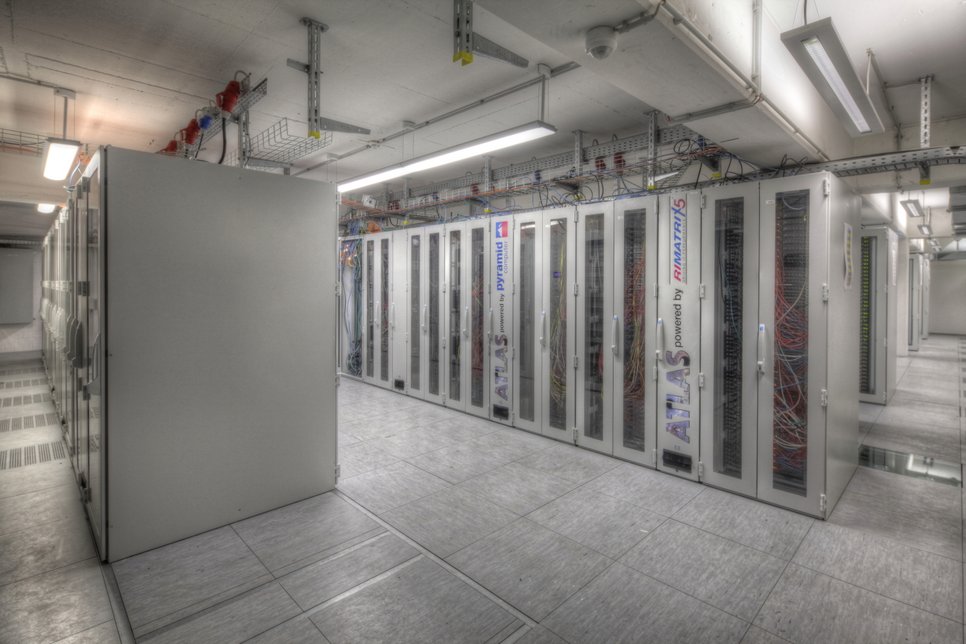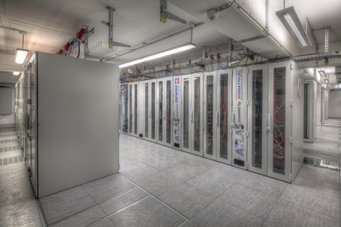The launch of ATLAS
Germany's fourth-fastest computer for scientific purposes is being inaugurated
In the future, all relevant data from the gravitational wave detectors LIGO (USA), GEO600 (German-British) and Virgo (Italian-French) will converge in Hannover - ATLAS is seeking to confirm the first direct measurement of gravitational waves
We cordially invite you to the launching of the ATLAS computer cluster:
on 22 May 2008, at 3 p.m.
at the Center for Gravitational Physics/Albert Einstein Institute, Hannover
Callinstr. 38, 30167 Hannover.
ATLAS is the world's largest and fastest cluster (by a factor of four) that will mainly be used to analyse data from gravitational wave observatories. As of next Thursday, all data from the observatories in the USA (LIGO) and Europe (GEO600 and Virgo) that are conducting measurement will converge in Hannover. In the current TOP500 list, ATLAS would be the fourth-fastest computer in Germany and would be ranked 38th in the supercomputer world rankings (www.top500.org).

“The ATLAS cluster is the world's largest resource for the analysis of gravitational waves. It combines approximately 1,400 individual computers, so-called nodes, with 5,684 CPU cores and, with over one petabyte, has about one-quarter of the storage capacity of CERN, which has the world's largest scientific computer memory,” says Prof. Bruce Allen, Director at the Max Planck Institute for Gravitational Physics, under whose leadership ATLAS emerged.
The components of the cluster, a multitude of single computers connected to a network that constitutes an individual computer, were manufactured and supplied by Pyramid Computer GmbH from Freiburg im Breisgau. In addition to the computing nodes and storage systems, Pyramid also delivered the network technology, which originated from the California-based start-up company Woven Systems. Working in close collaboration with scientists and technology experts, a highly innovative computer cluster has been developed that has a particularly favourable price-performance ratio: the calculation rate of more than 30 TeraFlops (flop: computing operations per second) was achieved at the unbeatable price of 1.7 million Euros. In addition to the Intel Xeon X3220 based pyramid calculation systems, the breakthrough speed was made possible by the innovative switch technology from Woven Systems, which allows the gigantic data streams of the gravitational wave observatories to be distributed in a non-blocking manner.
The programme:
3 p.m.
Welcome: Prof. Bruce Allen/Director of the AEI
Short welcoming speech: Dr. Josef Lange, State Secretary of Lower Saxony Ministry of Science and Culture
Dr. Carsten Aulbert, Dr. Henning Fehrmann/AEI: ATLAS Technology Highlights
Short welcoming speech: Frieder Hansen, Pyramid Computer GmbH
Todd Acree, Woven Systems
Andreas Stiller, c't Journal: Einstein's dream
3:30 p.m.
Launch
followed by reception
The detection of gravitational waves
The direct detection of the gravitational waves predicted by Albert Einstein - tiny ripples in space-time - remains one of the most important open questions of modern science. Their direct detection would lead us into an era of gravitational wave astronomy and provide completely new insights into our universe. With the help of gravitational waves one would be able to see all the way back to the first billionth of seconds of the universe and thereby solve many riddles about the genesis of our universe. Observation methods that have been used up to now have been unable to attain these insights.
The detection of gravitational waves would have, in addition to further confirming the general theory of relativity theory, far-reaching effects: for the first time, it would be possible to take a look into the “nursery” of the universe. Up to now observations of the sky have been restricted to using the electromagnetic spectrum (for example radio and X-ray telescopes as well as the observation of visible light). This only allows us information about the origins of the universe up to a maximum of 380,000 years after the Big Bang. Observations deeper into the past have remained hidden, since the universe only became transparent to electromagnetic radiation at this time. As a result, the various theories on the universe before this point remain experimentally unconfirmed. The direct measurement of gravitational waves would open completely new possibilities in this regard, since it is assumed that we will be able to then pursue the origins of the universe up to the first billionth of the first second that followed the Big Bang. Gravitational wave astronomy gives us access to completely new fields of science.
The Center for Gravitational Physics
is a joint research facility of the Max Planck Society and Leibniz Universität Hannover.
